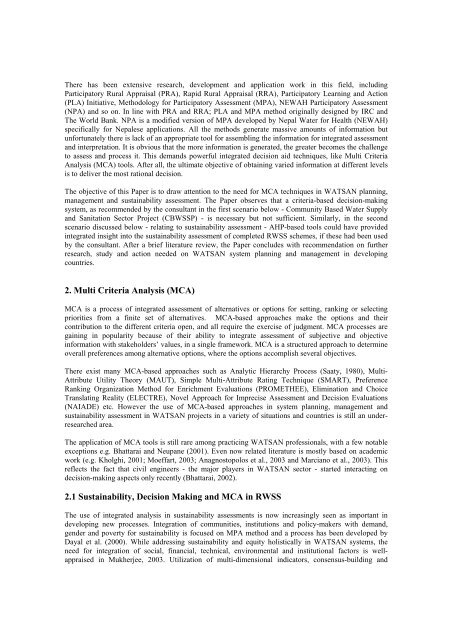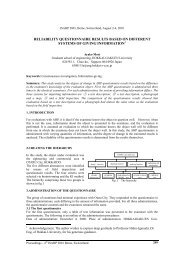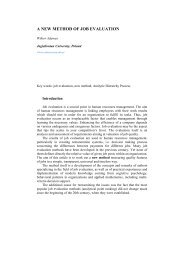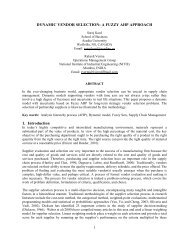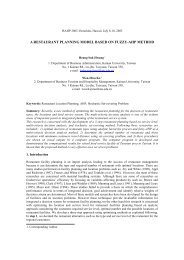Rural Water Supply And Sanitation In Developing Countries
Rural Water Supply And Sanitation In Developing Countries
Rural Water Supply And Sanitation In Developing Countries
You also want an ePaper? Increase the reach of your titles
YUMPU automatically turns print PDFs into web optimized ePapers that Google loves.
There has been extensive research, development and application work in this field, including<br />
Participatory <strong>Rural</strong> Appraisal (PRA), Rapid <strong>Rural</strong> Appraisal (RRA), Participatory Learning and Action<br />
(PLA) <strong>In</strong>itiative, Methodology for Participatory Assessment (MPA), NEWAH Participatory Assessment<br />
(NPA) and so on. <strong>In</strong> line with PRA and RRA; PLA and MPA method originally designed by IRC and<br />
The World Bank. NPA is a modified version of MPA developed by Nepal <strong>Water</strong> for Health (NEWAH)<br />
specifically for Nepalese applications. All the methods generate massive amounts of information but<br />
unfortunately there is lack of an appropriate tool for assembling the information for integrated assessment<br />
and interpretation. It is obvious that the more information is generated, the greater becomes the challenge<br />
to assess and process it. This demands powerful integrated decision aid techniques, like Multi Criteria<br />
Analysis (MCA) tools. After all, the ultimate objective of obtaining varied information at different levels<br />
is to deliver the most rational decision.<br />
The objective of this Paper is to draw attention to the need for MCA techniques in WATSAN planning,<br />
management and sustainability assessment. The Paper observes that a criteria-based decision-making<br />
system, as recommended by the consultant in the first scenario below - Community Based <strong>Water</strong> <strong>Supply</strong><br />
and <strong>Sanitation</strong> Sector Project (CBWSSP) - is necessary but not sufficient. Similarly, in the second<br />
scenario discussed below - relating to sustainability assessment - AHP-based tools could have provided<br />
integrated insight into the sustainability assessment of completed RWSS schemes, if these had been used<br />
by the consultant. After a brief literature review, the Paper concludes with recommendation on further<br />
research, study and action needed on WATSAN system planning and management in developing<br />
countries.<br />
2. Multi Criteria Analysis (MCA)<br />
MCA is a process of integrated assessment of alternatives or options for setting, ranking or selecting<br />
priorities from a finite set of alternatives. MCA-based approaches make the options and their<br />
contribution to the different criteria open, and all require the exercise of judgment. MCA processes are<br />
gaining in popularity because of their ability to integrate assessment of subjective and objective<br />
information with stakeholders’ values, in a single framework. MCA is a structured approach to determine<br />
overall preferences among alternative options, where the options accomplish several objectives.<br />
There exist many MCA-based approaches such as Analytic Hierarchy Process (Saaty, 1980), Multi-<br />
Attribute Utility Theory (MAUT), Simple Multi-Attribute Rating Technique (SMART), Preference<br />
Ranking Organization Method for Enrichment Evaluations (PROMETHEE), Elimination and Choice<br />
Translating Reality (ELECTRE), Novel Approach for Imprecise Assessment and Decision Evaluations<br />
(NAIADE) etc. However the use of MCA-based approaches in system planning, management and<br />
sustainability assessment in WATSAN projects in a variety of situations and countries is still an underresearched<br />
area.<br />
The application of MCA tools is still rare among practicing WATSAN professionals, with a few notable<br />
exceptions e.g. Bhattarai and Neupane (2001). Even now related literature is mostly based on academic<br />
work (e.g. Kholghi, 2001; Moeffart, 2003; Anagnostopolos et al., 2003 and Marciano et al., 2003). This<br />
reflects the fact that civil engineers - the major players in WATSAN sector - started interacting on<br />
decision-making aspects only recently (Bhattarai, 2002).<br />
2.1 Sustainability, Decision Making and MCA in RWSS<br />
The use of integrated analysis in sustainability assessments is now increasingly seen as important in<br />
developing new processes. <strong>In</strong>tegration of communities, institutions and policy-makers with demand,<br />
gender and poverty for sustainability is focused on MPA method and a process has been developed by<br />
Dayal et al. (2000). While addressing sustainability and equity holistically in WATSAN systems, the<br />
need for integration of social, financial, technical, environmental and institutional factors is wellappraised<br />
in Mukherjee, 2003. Utilization of multi-dimensional indicators, consensus-building and


